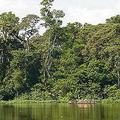 位處世界第二大雨林區的剛果民主共和國,27日宣佈將屬地內至少50,190平方英哩規劃為新的保護區。現階段剛果9%的國土,相當於8,494平方英哩,已在保護區中多項規定的保護傘下受到保育。
位處世界第二大雨林區的剛果民主共和國,27日宣佈將屬地內至少50,190平方英哩規劃為新的保護區。現階段剛果9%的國土,相當於8,494平方英哩,已在保護區中多項規定的保護傘下受到保育。
德國聯邦環境部長加布里爾(Sigmar Gabriel)對此表示:「剛果民主共和國政府透過建立新的保護區來保育珍貴的森林資源,同時確保住民能永續善用資源,看到這樣的決心與舉動,實在令我相當動容」。「保護該國內廣大面積的林地,維持它巨大的碳儲量,勢必有助於緩和氣候的變遷以及保護森林中生物多樣的富蘊性,這項決定將可讓包括剛果民主共和國在內的國際社會受益甚多」。
加布里爾向剛果環境部長波農戈(José Endundo Bononge)建議道,新設立的保護區可與新全球「生活網絡倡議」(LifeWeb Initiative)相結合。此倡議的目標在於藉由提升全球夥伴關係,輔助生物多樣性會議(Convention on Biological Diversity, CBD)之保護區工作計劃的執行;而作用則是對於自願承諾將新設置保育區,和加強當前保護區內永續經營的國家,提供資金上的援助。
剛果民主共和國裡有五座國家公園榮列世界遺產,同時卻也是聯合國教科文組織(UNESCO)瀕危世界遺產名單上的其中五座遺址。1998年至2003年間,剛果曾經歷第二次內戰炮火的摧殘,隨之而來的破碎經濟間接危及生物的多樣性。大多數的公園管理首長不是在戰爭中喪生,就是可能因負擔不堪而放棄他們的工作。
 不過,今日在剛果盆地的另一端,剛果木材產業(Congolaise Industrielle des Bois)協同「熱帶森林信託」(Tropical Forest Trust, TFT)宣佈,該林業公司所管理的雨林認證,已擴展為在剛果盆地內運作面積的2倍大,建立起世界最廣大相連的熱帶森林認證區。
不過,今日在剛果盆地的另一端,剛果木材產業(Congolaise Industrielle des Bois)協同「熱帶森林信託」(Tropical Forest Trust, TFT)宣佈,該林業公司所管理的雨林認證,已擴展為在剛果盆地內運作面積的2倍大,建立起世界最廣大相連的熱帶森林認證區。
在與熱帶森林信託合作的夥伴關係中,其中一項創新技術就是參與地圖標示(participatory mapping),即利用為文盲與半遊牧的匹客美人(Pygmies)量身設計的圖像式全球定位系統(GPS),藉其攜帶裝置在林地中穿梭的方式,找出育有重要資源的地區。資源地圖以這些資料為基礎,有助於搭起森林住民與林業公司之間的橋樑,並讓雙方得以進行公平的協商。
熱帶雨林信託執行主任波殷頓(Scott Poynton)指出,與剛果木材產業公司的夥伴關係只是鳴槍起跑,「剛果盆地內的森林破壞情形持續拉警報,我們必需尋思新的機制來對應」。有鑑於此,信託正計劃推展「剛果盆地森林社會卓越中心」(the Centre of Social Excellence for the Forests of the Congo Basin)。這項計劃的重點將著眼於增進林業公司與原住民部落之間的相識共生,並透過提供中非的大學畢業生另類就業機會,擔任森林管理專家,以鼓勵民間與企業的對話和森林保育的永續性。
The government of the Democratic Republic of the Congo today announced plans to designate at least 50,190 square miles of the Earth's second largest rainforest region as new protected areas. At present, nine percent of country, corresponding to 8,494 square miles, is conserved in various categories of protected areas.
"I was deeply impressed by the decision of the Democratic Republic of the Congo to conserve its forest resources by establishing new protected areas, while at the same time ensuring sustainable use by the inhabitants," German Federal Environment Minister Sigmar Gabriel said. "This will benefit not only the Democratic Republic of the Congo, but also the international community, for protecting the country's vast forests with their enormous carbon stocks helps to mitigate climate change and conserve the wealth of this forest biodiversity."
The German minister suggested to Congolese Minister José Endundo Bononge that the new protected areas be incorporated into the new global LifeWeb Initiative. The initiative aims to support the implementation of the Convention on Biological Diversity, CBD, Program of Work on Protected Areas through enhancing partnerships at a global level. The initiative will match voluntary commitments for the designation of new protected areas and the improved management of existing areas with commitments for dedicated financing of these areas.
Five of the Democratic Republic of the Congo's national parks are listed as World Heritage Site. All five sites are listed by UNESCO as World Heritage In Danger. From 1998 to 2003, the country suffered from the devastating Second Congo War. The civil war and resulting poor economic conditions have endangered much of this biodiversity. Most park wardens were either killed or could not afford to continue their work.
Elsewhere in the Congo Basin today, the timber company and the Tropical Forest Trust, TFT, announced that the company has more than doubled the amount of certified rainforest it operates in the Congo Basin, creating the world's largest tract of contiguous certified tropical forest.
One of the innovative techniques developed during this partnership is participatory mapping. Using icon-based Global Positioning System, or GPS, units designed for non-literate people, the semi-nomadic Pygmies living within the forest concession walk through their forest and locate resources or areas of significance. This data forms the basis for resource maps, which bridge the communication gap between the people in the forest and the forest company and enable a fair negotiation.
The partnership with Congolaise Industrielle des Bois is just the start, said Scott Poynton, TFT's executive director. "Forest destruction in the Congo Basin continues at an alarming rate and we need to find new mechanisms for scaling up." To accomplish this, the Trust is launching the Centre of Social Excellence for the Forests of the Congo Basin. This new project will focus on improving the understanding and linkages between forestry companies and indigenous communities. It will encourage dialogue and sustainability by offering recent graduates of central African universities opportunities to become experts in forest management.
全文及圖片詳見:ENS



